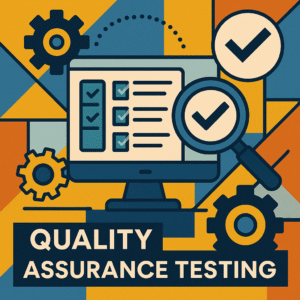Top 10 Test Automation Pitfalls and How to Avoid Them: An Insider's Guide
Last Updated: August 19, 2025
Ready to build a successful automation strategy? See how CloudQA’s intuitive platform helps you sidestep common pitfalls from day one. Explore our CloudQA today.

Table of Contents
Introduction: A Decade of Lessons in Test Automation
In a tech-driven world, progress is constant. The days of teams spending countless hours on repetitive manual testing are fading fast. Automated testing is no longer a trend; it’s a foundational element of modern software development, celebrated for its speed and efficiency. With over ten years of experience at CloudQA, we’ve partnered with a diverse range of clients, from startups taking their first steps into automation to large enterprises executing full-scale transformations. This vantage point has given us a unique insight into what separates a successful automation initiative from one that fails to deliver.
While the benefits of automation are immense, the path to achieving them is filled with potential challenges. This guide is packed with our personal take on the ten most common pitfalls we’ve seen teams encounter and, more importantly, the practical, actionable ways to avoid them.
1. The Pitfall: Unclear Goals and Objectives
The Pitfall: Embarking on a test automation journey without a clear destination is the most common reason for failure. Teams often start with a vague goal like “automate everything,” which leads to wasted effort on low-value tests, misaligned priorities, and an inability to demonstrate tangible success to stakeholders.
The Consequences: This lack of direction results in “automation for automation’s sake.” The team might boast about having 500 automated tests, but if none of them cover the critical, revenue-generating workflows, the initiative provides a false sense of security while real bugs slip into production.
How to Avoid It:
- Define SMART Objectives: Your goals must be Specific, Measurable, Achievable, Relevant, and Time-bound. Instead of “automate our tests,” a better goal is “Automate 80% of our regression test suite for the checkout workflow by the end of Q3 to reduce manual testing time by 15 hours per release.”
- Involve All Stakeholders: Bring business analysts, product managers, and developers into the planning process. This ensures that the testing goals align with the overall business needs and provides a fresher perspective on what’s truly important to automate.
- Establish Key Metrics: Set standard metrics to track the success of your automation efforts from day one. This could include test execution time, percentage of test coverage for critical modules, and the number of bugs found by automation.
2. The Pitfall: Poor or Inadequate Test Planning
The Pitfall: Inadequate test planning is like building a house without a blueprint. It often leads to missed scenarios, inefficient test execution, and critical gaps in test coverage, ultimately undermining the effectiveness of the entire automation effort.
The Consequences: Without a solid plan, teams tend to automate tests randomly. This results in a chaotic and unreliable test suite that is difficult to manage and fails to provide a clear picture of the application’s health.
How to Avoid It:
- Create a Comprehensive Test Strategy: Start with a thorough plan that outlines the scope of automation, the types of tests to be automated (UI, API, etc.), and the environments to be covered.
- Prioritize Based on Risk and Impact: Not all tests are created equal. Build your test strategy by prioritizing test cases based on business risk and user impact. Focus on automating critical business workflows, high-traffic user journeys, and functionality that is prone to regression.
- Adopt the Test Automation Pyramid: Plan your automation efforts with the pyramid model in mind: a large base of fast, stable unit tests; a smaller layer of integration tests; and a very small number of broad end-to-end UI tests. This creates a more stable and maintainable test portfolio.
3. The Pitfall: Choosing the Wrong Automation Tools
The Pitfall: Selecting a tool that is a poor fit for your project is a costly mistake. It can lead to severe compatibility issues, wasted time trying to work around its limitations, and low testing efficiency, ultimately hurting your budget and timeline.
The Consequences: The wrong tool can bring your automation initiative to a grinding halt. If it doesn’t integrate with your CI/CD pipeline or if your team lacks the skills to use it effectively, the expensive new tool will quickly become shelfware.
How to Avoid It:
- Define Your Requirements First: Before looking at any tools, list down your project’s technical requirements, the types of tests you need to run, and the skillset of your team.
- Evaluate Tools Systematically: Research and compare tools based on their ease of use, integration capabilities, vendor support, and cost. Don’t just look at features; consider the total cost of ownership, including training and maintenance.
- Conduct a Proof of Concept (POC): Never commit to a tool without trying it first. Select your top two or three candidates and conduct a POC by automating a small but representative part of your application. Look for “DIY sessions” or free trials to get hands-on experience.
4. The Pitfall: Poorly Designed and Brittle Test Cases
The Pitfall: Test cases that are poorly designed are a maintenance nightmare. They often result in incomplete testing, unreliable results, and a high number of “flaky” tests that fail for reasons unrelated to a real bug.
The Consequences: Flaky tests erode the team’s trust in the automation suite. If developers are constantly chasing down false positives, they will start to ignore the test results altogether, defeating the purpose of automation.
How to Avoid It:
- Focus on Atomic and Independent Tests: Each test case should be small, focused on a single piece of functionality, and able to run independently without relying on other tests.
- Design for Reusability: Don’t hesitate to design tests in a way that components can be reused. Create modular, reusable functions for common actions like logging in or searching for a product. This makes tests easier to build and far easier to maintain.
- Separate Test Data from Test Logic: Hardcoding data directly into your test scripts makes them brittle. Externalize your test data into separate files (like CSVs or JSON) so that tests can be run with different data sets without changing the underlying script.
5. The Pitfall: Overlooking Test Maintenance
The Pitfall: Many teams view test automation as a one-time setup. This is a critical mistake. Overlooking the health of your automation suite leads to outdated, unreliable tests that fail to adapt to application changes, resulting in missed defects or a constant stream of false positives.
The Consequences: An unmaintained test suite quickly becomes “technical debt.” Over time, so many tests will be broken and outdated that it becomes easier to abandon the entire suite and start over than to fix it.
How to Avoid It:
- Schedule Regular Reviews: Regularly review and update test scripts as the application evolves.
- Allocate Time for Maintenance: Treat your test code like you treat your application code. Allocate dedicated time in every development cycle or sprint for refactoring and maintaining existing tests.
- Use Tools That Reduce Maintenance: Modern codeless tools often include features like AI-powered self-healing that can automatically adapt to minor UI changes, significantly reducing the maintenance burden.
6. The Pitfall: Neglecting Continuous Integration (CI)
The Pitfall: Without integrating automation into a Continuous Integration (CI) pipeline, tests are run infrequently and manually. This leads to the delayed detection of bugs and a much higher risk of faulty code being merged and integrated.
The Consequences: This leaves all your development and testing processes out of sync. A bug that could have been caught and fixed in minutes on the day it was introduced might not be found for weeks, by which time it is much more complex and expensive to fix.
How to Avoid It:
- Automate Your Pipeline: Set up an automated CI pipeline (using tools like Jenkins, GitLab CI, or GitHub Actions) where your test suite is automatically executed after every single code change.
- Ensure Fast Feedback: The goal of CI is to provide rapid feedback to developers. Optimize your test suite to run quickly so that developers know within minutes if their change has broken something.
- Choose CI-Friendly Tools: When selecting your automation tool, ensure it supports easy integration with your version control systems and build servers.
7. The Pitfall: Lack of Proper Documentation and Monitoring
The Pitfall: Improper reporting and documentation can steer you away from the actual progress of your tasks. Without clear, timely insights, you may overlook frequent changes, recurring bugs, or drops in test coverage.
The Consequences: Without good monitoring, you are flying blind. You won’t know if your automation efforts are actually improving quality, and you won’t have the data to justify the investment to stakeholders.
How to Avoid It:
- Implement a Test Management Tool: Use established tools to keep everyone updated on test progress, coverage, and results.
- Create Actionable Dashboards: Your reporting should provide at-a-glance insights. Create dashboards that track key metrics like pass/fail rates over time, test execution duration, and test flakiness.
- Communicate Insights Regularly: Reporting insights from time to time can help better channel team members to work together at every step.
8. The Pitfall: A Shortage of Skilled Resources
The Pitfall: A lack of skilled resources often results in inefficient automation, improper tool usage, and an inability to create reliable and maintainable test scripts.
The Consequences: An unskilled team can do more harm than good, creating a flaky and unmaintainable test suite that costs more to manage than the value it provides.
How to Avoid It:
- Invest in Training: Upskill your current team on modern automation tools, frameworks, and best practices through workshops, certifications, or mentorship programs.
- Adopt User-Friendly Tools: Lower the skill barrier by adopting codeless or low-code automation platforms. These tools empower your existing manual testers and business analysts to contribute to automation without needing to become expert coders.
- Hire Strategically: When hiring, look for talent with a mix of strong testing fundamentals and technical skills. If needed, consider using consultants to fill immediate gaps while you develop your internal resources.
9. The Pitfall: A High Upfront Investment with Unclear ROI
The Pitfall: A high upfront investment in expensive automation tools and lengthy setup can strain resources and delay the Return on Investment (ROI), making it difficult to justify the costs.
The Consequences: If the initiative doesn’t show value quickly, it can lose support from management, leading to budget cuts and a premature end to the project.
How to Avoid It:
- Start Small and Show Quick Wins: Begin by automating a small set of high-value, repetitive tests to demonstrate early ROI.
- Consider Scalable Pricing Models: Look for open-source tools or commercial platforms that offer scalable, pay-as-you-go pricing. This allows you to start small and grow your investment as the value becomes clear.
- Track Your ROI Diligently: Keep solid plans to track your ROI. Measure not just the time saved in manual testing but also the reduction in post-release bugs and the increased speed of delivery.
10. The Pitfall: Setting Unrealistic Expectations
The Pitfall: Unrealistic expectations can lead to major disappointment when automation doesn’t immediately solve all quality problems, eliminate manual testing entirely, or deliver flawless cost savings.
The Consequences: When reality doesn’t match the hype, stakeholders can become disillusioned, and the project can be unfairly labeled a failure, doubling the team’s workload and hurting morale.
How to Avoid It:
- Educate Stakeholders: Be clear that automation is a long-term investment, not a magic bullet. It requires ongoing effort and will not replace the need for skilled human testers.
- Understand Its Limitations: It’s easy to exploit technologies like AI and self-healing tools, but there are still shortcomings. Some types of testing, like exploratory and usability testing, still require human intuition and judgment.
- Set Boundaries and Be Cautious: Stay highly cautious and set clear boundaries on what the tools are expected to do. Continuously bridge the knowledge gap to better understand the work and its limitations.
Final Takeaways: The Human Element in Automation
The success of any test automation initiative hinges on more than just technology. As our experience has shown, human involvement remains unbeatable. The key is to choose the right tools and empower your team with the right knowledge and processes. By being mindful of these common pitfalls, you can not only overcome challenges as they arise but also build a resilient and effective automation strategy that avoids them from the start.
RECENT POSTS
Guides

How To Select a Regression Testing Automation Tool For Web Applications
Regression testing is an essential component in a web application development cycle. However, it’s often a time-consuming and tedious task in the QA process.

Switching from Manual to Automated QA Testing
Do you or your team currently test manually and trying to break into test automation? In this article, we outline how can small QA teams make transition from manual to codeless testing to full fledged automated testing.

Why you can’t ignore test planning in agile?
An agile development process seems too dynamic to have a test plan. Most organisations with agile, specially startups, don’t take the documented approach for testing. So, are they losing on something?

Challenges of testing Single Page Applications with Selenium
Single-page web applications are popular for their ability to improve the user experience. Except, test automation for Single-page apps can be difficult and time-consuming. We’ll discuss how you can have a steady quality control without burning time and effort.

Why is Codeless Test Automation better than Conventional Test Automation?
Testing is important for quality user experience. Being an integral part of Software Development Life Cycle (SDLC), it is necessary that testing has speed, efficiency and flexibility. But in agile development methodology, testing could be mechanical, routine and time-consuming.







Comments are closed.